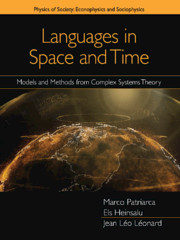Chapter 1 - Introduction
Published online by Cambridge University Press: 04 June 2020
Summary
Introduction to Complexity
Complexity theory is a major interdisciplinary paradigm which unifies naturaland social sciences through a combination of quantitative and qualitativemethods applied at various phases of the research, from observations anddata analysis to modeling, simulation, and interpretation of complexphenomena (Anderson, 1972; Ross and Arkin, 2009). In this framework,cognitive and nonlinear stochastic models and effective representationmethods such as complex networks and fractal geometry, represent a part ofthe standard toolbox. In fact, in complexity theory, phenomena emergedynamically from hierarchical, multi-modular systems, produced by bundles ofpossibly stochastic interactions and causalities rather than fromcorrelative determinism.
As far as language and linguistic analysis are concerned, complexity itselfcan be understood from at least two different perspectives. On the one hand,there is ‘constitutional complexity’, or ‘bitcomplexity’, that is, complexity due to inventories of functionalunits or structural features, such as phonemes, morphemes, and lexicalstems. On the other hand, there is ‘(socio-)interactionalcomplexity’, or, in other words, ‘communal complexity’,involving intricate modules of units and features, or networks ofinteractive individuals and aggregates. These different aspects all findtheir natural description in the multiplex paradigm, thatis, through a model system composed of a set of interacting, overlappingnetworks. The unification of the two aforementioned dimensions of complexityrepresents a major challenge and is a focus point of this book.
For more than a decade, a growing interdisciplinary community has applied thetools of complex systems theory and statistical mechanics to the study ofproblems that traditionally belong to the field of linguistics. Nowadays,language dynamics represents a relevant branch of complexity theory. Themodeling of language dynamics has mainly addressed three fundamentaldimensions of language complexity.
(i) Language spread and competition (the dynamics of languageuse in multilingual communities).
(ii) Language evolution (how the structure of languageevolves).
(iii) Language cognition (the way the human brain processeslinguistic knowledge).
While these three dimensions of language complexity closely interact witheach other and should all be taken into account for an exhaustivedescription of language complexity, it is useful, for clarity, to considerthem as separate aspects. In the present book, we mainly address the firsttwo dimensions, discussing language spread and competition models andconsidering language evolution models. However, we will also usesocio-cognitive models of linguistic and cultural change.
- Type
- Chapter
- Information
- Languages in Space and TimeModels and Methods from Complex Systems Theory, pp. 1 - 6Publisher: Cambridge University PressPrint publication year: 2020



